How to Practice Mindfulness Daily: A Simple Guide to Living in the Moment
Did you know that just 10 minutes of daily mindfulness can significantly improve your mental health? In today’s fast-paced world, many of us are constantly juggling tasks, scrolling through our phones, or worrying about tomorrow — rarely pausing to be fully present.
If you’ve ever wondered how to practice mindfulness daily without disrupting your routine, this guide will walk you through simple, science-backed strategies to bring more peace, clarity, and joy into your life.
From morning rituals to evening wind-downs, we’ll cover everything you need to build a sustainable mindfulness habit — no meditation experience required.
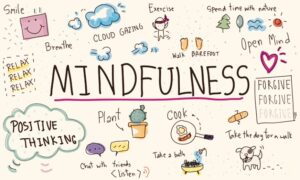
The Problem: Why We Need Mindfulness Now More Than Ever
In the age of constant connectivity, it’s easy to feel overwhelmed, anxious, or disconnected from ourselves. The average person checks their phone over 80 times a day, often without even realizing it. This digital distraction pulls us away from the present moment and fuels chronic stress.
- We multitask too much
- We’re always planning the next thing
- We rarely take time to breathe deeply
Mindfulness helps counteract these habits by training your brain to focus on the now — not what happened yesterday or what might happen tomorrow.
How to Practice Mindfulness Daily: A Step-by-Step Guide
1. Start Your Day with Intention
Instead of jumping straight into emails or social media, spend the first 5–10 minutes of your day grounding yourself.
- Take 5 deep breaths before getting out of bed
- Drink a glass of water mindfully (notice the temperature, texture, taste)
- Set a positive intention for the day (“Today I choose calm”)
2. Practice Mindful Breathing Throughout the Day
One of the simplest yet most powerful mindfulness techniques is conscious breathing.
- Sit comfortably or stand still
- Close your eyes if possible
- Inhale deeply through your nose for 4 seconds
- Hold the breath for 4 seconds
- Exhale slowly through your mouth for 6 seconds
This technique, known as box breathing, can be done anytime — while waiting in line, during a break at work, or before an important meeting.
3. Eat Meals Without Distractions
Mindful eating means paying full attention to your food — its taste, smell, texture, and how it makes your body feel.
- Turn off the TV and put away your phone
- Chew slowly and savor each bite
- Notice when you start feeling full
4. Take Mindful Walks
Walking is a great opportunity to reconnect with your senses and surroundings.
- Walk slowly and deliberately
- Notice the feel of your feet touching the ground
- Listen to the sounds around you
- Breathe in fresh air consciously
5. Wind Down with a Gratitude Reflection
End your day by reflecting on three things you’re grateful for.
- Write them down in a journal
- Think about how they made you feel
- Let gratitude replace any lingering stress
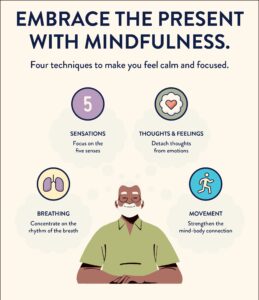
Mindfulness Best Practices: Tips That Make It Stick
Keep It Consistent, Not Perfect
You don’t need hours of meditation to benefit from mindfulness. Even 2–3 minutes of focused breathing counts. What matters most is consistency.
Use Reminders and Triggers
Link mindfulness practices to everyday actions:
- Every time your phone rings, pause and take a breath
- Before starting your car, check in with how you’re feeling
- At every red light, do a quick body scan
Create a Calm Space
Designate a small corner of your home where you can sit quietly and reflect. Add calming elements like candles, plants, or soft music.
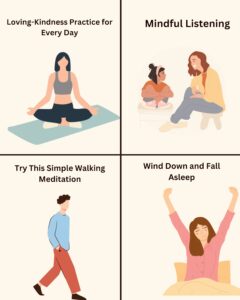
Common Mistakes to Avoid When Practicing Mindfulness
Trying Too Hard
Mindfulness isn’t about forcing yourself to be “perfectly calm.” It’s about observing your thoughts without judgment. If your mind wanders, gently bring it back — no criticism needed.
Expecting Immediate Results
Like any skill, mindfulness takes time to develop. You may not notice changes right away, but over time, you’ll likely feel more centered and resilient.
Mistaking It for Escapism
Mindfulness isn’t about avoiding problems — it’s about facing them with greater clarity and emotional balance. It empowers you to respond thoughtfully rather than react impulsively.
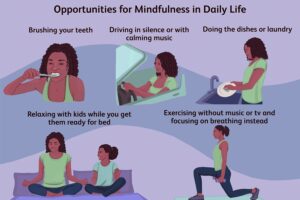
Expert Insights: What the Research Says
According to a study published in JAMA Internal Medicine, mindfulness meditation can help ease anxiety, depression, and pain.
Dr. Jon Kabat-Zinn, founder of the Mindfulness-Based Stress Reduction (MBSR) program, says:
“Mindfulness is the awareness that arises through paying attention, on purpose, in the present moment, non-judgmentally.”
Another real-world example comes from Google’s “Search Inside Yourself” program, which integrates mindfulness into corporate culture. Employees report higher productivity, better focus, and improved emotional intelligence after participating.
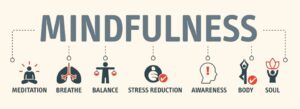
FAQ: Frequently Asked Questions About Daily Mindfulness
What is the best time to practice mindfulness?
The best time is whenever you can consistently commit to it — whether it’s first thing in the morning, during lunch, or before bed.
Do I need to meditate to be mindful?
No. While meditation is one form of mindfulness, you can also practice it during everyday activities like walking, eating, or even doing dishes.
Can mindfulness help with anxiety?
Yes. Studies show that regular mindfulness practice can reduce symptoms of anxiety by helping you stay grounded and less reactive to stressors.
How long should I practice mindfulness each day?
Even 5 minutes a day can make a difference. Aim for consistency rather than duration.
Is mindfulness religious?
Mindfulness has roots in Buddhist traditions but is practiced secularly by millions worldwide. It doesn’t require any spiritual beliefs to benefit from it.
Final Thoughts: Start Small, Stay Consistent
Practicing mindfulness daily doesn’t have to be complicated or time-consuming. By incorporating small moments of awareness throughout your day, you can gradually build resilience, reduce stress, and enjoy life more fully.
Remember, mindfulness is a journey — not a destination. Be patient with yourself and celebrate small wins along the way.
If you found this guide helpful, leave a comment below sharing your favorite tip or your biggest challenge when practicing mindfulness!
